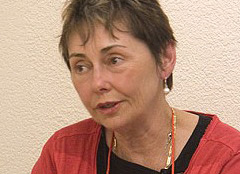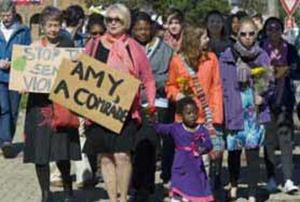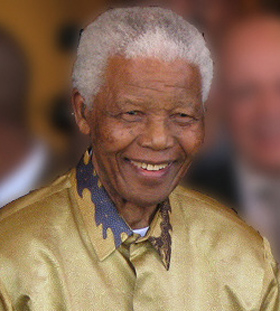Q&A: Nancy Scheper-Hughes revisits South Africa in the mid-1990s
Nancy Scheper Hughes, who assembled speakers from around the world for the campus's first event honoring Nelson Mandela. describes how she met many of them while working as an anthropologist in South Africa in the mid-1990s.
April 23, 2014
For the campus’s Monday, April 28, event honoring Nelson Mandela, campus anthropologist Nancy Scheper-Hughes has assembled key figures connected to the anti-apartheid struggle to share their personal stories about how Mandela changed their lives. Scheper-Hughes recently talked about her own dramatic experiences in the 1990s in South Africa and how she first met some of the speakers.

UC Berkeley anthropology professor Nancy Scheper-Hughes
Q: You were in South Africa in the summer of 1993, a year before Mandela’s election, when Stanford University graduate Amy Biehl was killed during an angry demonstration. Why were you there? And what was the political climate like at the time?
A: I arrived in July 1993, having been invited to be the chair of social anthropology for the University of Cape Town. My husband and three college-age children were with me. It was a fairly terrifying time. The apartheid regime was being dismantled, and there was a great deal of violence during the months before the elections. I actually had an escape route planned through Mozambique! There were a series of massacres of whites by black South Africans in retaliation for the literally thousands of black South Africans killed by the South African Defense Force, which then lied about its illegal actions.
As a medical anthropologist, I wanted to know the actual numbers – of blacks and whites killed – and whether their causes of death were being covered up by the apartheid state. I went to the Salt River Police Mortuary in Cape Town following the death of Amy Biehl and the deaths of those in the St. James Church and Heidelberg Pub massacres, which took place within a three-month period in Cape Town. As visiting chair of the anthropology department, I also asked the faculty to reflect on the discipline and on how to use anthropology to go forward in building a more democratic South Africa. And I introduced some courses that included one on the anthropology of violence and the body.
What connection did you have to Amy Biehl and other American students in South Africa, and how did you learn of her death?
My husband and I were like dorm parents to the Fulbright students who had come to the University of Cape Town. I didn’t know Amy before her death because she was at the University of the Western Cape, and it was a 45-minute drive to get there. But she was friends with all the other Fulbright students we knew.
The night of July 25, Michael and I were at a lecture at the university when we were told that a tall white young woman had been pulled from her car and stoned and stabbed to death, and that she looked like our daughter, Sarah. I grabbed Mike, and we were in a trance. We ran through every red light to get to our apartment building, and when we opened the door, 1-2-3, our children were all there, and four Fulbright students. “Are we all accounted for?” I asked. But one of them said, “Well, there’s Amy. And I just bought her car, because she’s going home tomorrow. But she would know to stay away from the townships at a fraught time like this.”
We went to bed, but at 6 a.m., there was a phone call that it was Amy. She was driving friends home in Gugulethu township when 60 to 70 black teens, riled up after attending a political youth meeting, got off a train nearby, shouting the rallying cry “One settler, one bullet!” and attacked her car.
What memories stand out for you immediately after her death?

On the 20th anniversary of Amy Biehl’s death in South Africa, Professor Nancy Scheper-Hughes (left) and Biehl’s mother, Linda, hold signs and walk with the young daughter of one of the men convicted in the Biehl case. (Photo courtesy of Nancy Scheper-Hughes)
The next day, we went to a memorial at the University of Western Cape to honor Amy Biehl. Then, I chose to go on a multiracial march into the township to the spot where Amy died. I was the only white face on a school bus headed into what was a “no go” zone for whites at the time. The tension was pungent, there was a smell of fear among the people marching. I carried a sign saying, “Stop the senseless violence.” But I thought about the senseless violence of the South African police, and so I picked up another two signs, one saying “Amy, a Comrade,” and the other, “Farewell , Amy.”
I carried those signs home with me and then all the way back to Gugulethu last August for the 20th anniversary march for Amy.
How did you come to know Ntobeko Peni and Easy Nofemela, two of the four young men convicted in the Biehl case, and Amy Biehl’s parents?
The trial began in early December, and I decided I would go as often as I could. I soon met Linda and Peter Biehl, who came to South Africa from Newport Beach, and they were totally devastated. But they also had the notion that Amy was now their guiding light.
Neither Easy nor Ntobeko had held the knife that was used on Amy. They tried to explain to the court the context of the mob action, that they were militants, part of a South African black nationalist movement, and that they thought the attack was necessary to bring about change. Upstairs in the courthouse, radical youth were dancing while Amy’s death was described. Easy turned around and said, “What’s wrong with you? Stop that!”
I went to their Truth and Reconciliation Commission hearings after they were out of prison in 1997. It was not a court of law, but an African National Congress (ANC) government-led restorative justice body created to gather information for the purpose of resolving the wounds and scars left by apartheid. Victims, perpetrators and those who might have been both at one time or another came forward to tell their stories and, for the perpetrators, to get conditional amnesty. The Biehls were there and said they didn’t want to interfere with the amnesty of those convicted of Amy’s death. They already had started building the Biehl Foundation in her memory. They had set up a bakery, a golf course and an after school program in Gugulethu to give training and jobs to young people like Ntobeko and Easy.
Later, in 1999, I went back to South Africa to follow up on my research. The young men’s lawyer said that Ntobeko and Easy weren’t doing well, that what they had done laid heavily on them, but that they had an idea about something that might help them, and that I could help. They said they were stigmatized, living without work and having difficulty in relationships. They said they’d seen Linda and Peter Biehl and wanted to tell them how incredible they were, that they were hero parents to do this work in their community. And they wanted to have their forgiveness.

Linda Biehl and Easy Nofemela, one of the men convicted in the death of Amy Biehl, at the 20th anniversary march. (Photo courtesy of Nancy Scheper-Hughes)
Were the Biehls and the young men able to reconcile?
I brought Peter to meet the young men, who were in a very poor part of the township. It didn’t go well at first, but they told Peter they were very depressed and wanted the Biehls to know that they were trying to work with youth, trying to steer them away from violence. Peter was getting tenser and tenser.
Then Easy came to us with a tea tray and knelt down in front of Peter and held a tea cup out to him, almost like in a Japanese tea ceremony, and said, “Please, have some tea.” Peter then had a change of heart and said, “I think I may have a job for you.” That was the beginning of them working for the foundation in after school programs that would involve thousands of children. Today, Ntobeko is program director of the Biehl Foundation. The people in Gugulethu have embraced this story as a story of true reconciliation.
Did you ever meet Nelson Mandela?
My son Nathaniel’s friend Cheryl Phillips worked for the South African Defense Department as a private secretary, and in 1997, she invited me to a party for the third opening of Parliament in the beautiful De Tuynhuys gardens that were an extension of Mandela’s presidential residence. I wasn’t dressed like the others, in their glorious outfits, since I had just come from the airport, so I ducked into a big tent and went into a corner to hide a little bit.
As I was walking quickly with my head down, I accidentally butted into someone. I looked up at this tall figure to see that it was Madiba himself! I fell down on my knees and kissed his hand, tears were coming down my face, and he helped me up, and my son and Cheryl chatted with him. I wasn’t able to say a word – and I’m a person who never keeps quiet! I was simply overwhelmed with his presence, his majesty. But I did walk with him, his arm tucked into mine, to the stage. And, of course, I heard him speak many times, including when he returned to Victor Verster prison, when Manfred Jacobs was a young warden.

Nelson Mandela, 2008 (South Africa The Good News via Wikimedia Commons)
What is your goal for the April 28 event?
Those who attend will hear that reconciliation is hard work – getting people to work together in whatever way – to build a better, new society, a more just state. This discussion will honor Mandela, who talked about this almost everywhere he went. They also will learn from a few of the speakers that, in the United States and elsewhere in the world, reparations have not been made for our history of slavery and segregation. We’ve never acknowledged the genocide of California Indians, small bands of hunters and gatherers and fishermen who were wiped out following the Gold Rush up through the beginning of the 20th century.
In his speech in Oakland on July 30, 1990, right after he got out of Victor Verster prison, Nelson Mandela said that he had received “priceless gifts from the first American nation, the American Indians.” He said that they had wanted to robe him at the airport, though he had already left. He said that the letters he had received from the California Native Americans had left him “very disturbed.” It was clear that Americans must attend to their own reparations and restorative justice before any true reconciliation could take place.
See also: Nelson Mandela to be honored at special campus event.